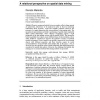Free Online Productivity Tools
i2Speak
i2Symbol
i2OCR
iTex2Img
iWeb2Print
iWeb2Shot
i2Type
iPdf2Split
iPdf2Merge
i2Bopomofo
i2Arabic
i2Style
i2Image
i2PDF
iLatex2Rtf
Sci2ools
IJDMMM
2008
2008
A relational perspective on spatial data mining
: Remote sensing and mobile devices nowadays collect a huge amount of spatial data, which have to be analysed in order to discover interesting information about economic, social and scientific problems. However, the presence of a spatial dimension adds some problems to data mining tasks. The geometrical representation and relative positioning of spatial objects implicitly define spatial relationships, whose efficient computation requires a tight integration of the data mining system with the spatial DBMS. The interaction between spatially close objects causes different forms of autocorrelation, whose effect should be considered to improve the predictive accuracy of induced models and patterns. Units of analysis are typically composed of several spatial objects with different properties and their structure cannot be easily accommodated by classical double entry tabular data. In the paper, a way is shown to face these problems when a (multi-)relational data mining approach is considered ...
Related Content
| Added | 12 Dec 2010 |
| Updated | 12 Dec 2010 |
| Type | Journal |
| Year | 2008 |
| Where | IJDMMM |
| Authors | Donato Malerba |
Comments (0)

